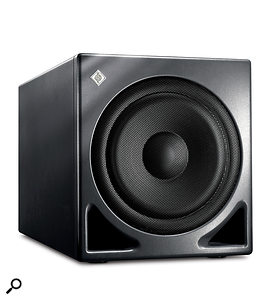Matt Houghton
I have all the acoustic treatment I can fit into my home studio already, and have a decent amp and good–quality (PMC) passive monitors, but I have trouble judging low frequencies — so I’m thinking of adding a subwoofer. What should I consider when selecting one, and is it a good idea in my situation?
Bill Gambles, via email

SOS Reviews Editor Matt Houghton replies: You don’t state what model of speaker you have, but PMC claim that their TB2 model, for example, offers a ‘useful’ frequency response down as low as 40Hz. I can think of very few music–making scenarios where you should need particularly accurate monitoring lower than that — and in those few cases you’d need a room that could cope. If your room can’t cope, and you really do need to judge the level of a 30–50Hz sine wave, then it’s a pretty trivial matter to check on a modern frequency analyser plug–in what’s going on.
Subwoofers aren’t necessarily the right answer to your bass–monitoring woes, particularly in studios that are set up in domestic spaces — no matter how high the quality of subwoofer.Subwoofers aren’t necessarily the right answer to your bass–monitoring woes, particularly in studios that are set up in domestic spaces — no matter how high the quality of subwoofer.With this in mind, I’d suggest that you start not by thinking about subwoofers, but by attempting to check what level of bass your speakers are actually putting out into your room: play some bass–rich material over them and stand in a corner of the room, where the bass build–up is likely to be greatest, and walk around the room boundary. If you can hear an increase in very low frequencies, then lack of bass from your speakers isn’t your main problem — and adding a sub will probably just prove to be an expensive way to make matters worse.
If your speakers are doing their job, you need to do something about the room. You say you’ve already installed as much acoustic treatment as you can, but perhaps you can reconsider the nature of the acoustic treatment you’ve installed. To achieve remotely accurate low–frequency monitoring in a domestic space the room must be treated with ample bass trapping. The idea is to absorb low-frequency waves so that they don’t bounce around the room causing all those nasty peaks and nulls. It’s pretty much impossible to install too much bass trapping, but often impossible to install enough! We’ve covered this subject many times over the years, but for ideas on relatively compact bass traps check out our Studio SOS feature from July 2006 (http://sosm.ag/studiosos-0706).
Of course, you may live in a rather grander residence than the one I pictured from your description, and perhaps have a large room or double garage at your disposal, with plenty of room for adequate bass trapping. In this case a sub might be worth considering — but even then, only once you’ve made efforts to treat the room properly. If you decide that you really do need a sub, then there’s a whole host of questions you need to answer, not just which model is best. Thankfully, our Technical Editor wrote an in–depth article on this very subject back in April 2007 (http://sosm.ag/all-about-subwoofers). I’d suggest reading that before you reach for your credit card!
No comments:
Post a Comment